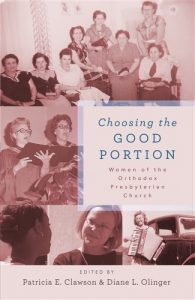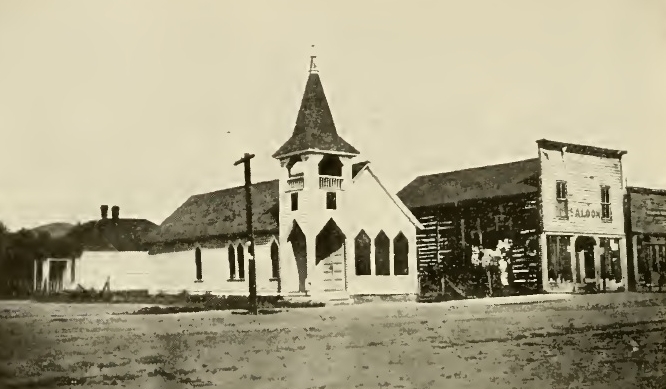Church and Saloon—The caption for the picture as it was published in The Church on the Changing Frontier, says “No Room for Both. The Presbyterian Church at Melrose, Montana, and its next-door neighbor, a saloon.” One can imagine a scene in a Sergio Leone western with Clint Eastwood striding towards the saloon with spurs jingling as he rolls his malformed cigarette between his parched lips, but then he staggers, his perpetually squinted eyes open wide as he utters in disbelief, “A church, next to a saloon!” However, churches and saloons were often neighbors in remote frontier areas and in some cases churches made use of a saloon owner’s property. If there was not a church building in town, a saloon sometimes had a hall above or next to it which could be rented for meetings. It is doubtful that the saloon keeper would close his business for the Sabbath, so a worship service may have had to deal with noise from the neighbors. In one case in Montana a church renovated a no longer used saloon for worship. The irony is that on the one hand, Presbyterians and other denominations of the day were often vocal proponents of temperance, but on the other hand, saloon property sometimes benefited the churches. For more about the Presbyterians in Montana see, The Pioneer Work of the Presbyterian Church in Montana, by George Edwards, date uncertain but after 1907.
 Website—Teaching Elder Caleb Cangelosi has a new website online titled Log College Press. He is the pastor of Pear Orchard Presbyterian Church (PCA), in Ridgeland, Mississippi. Caleb and C. N. Willborn published Selected Writings of Benjamin Morgan Palmer, Banner 2014, which was reviewed on Presbyterians of the Past. The eventual purpose of Caleb’s site is to distribute reprints of the works of nineteenth century and earlier Presbyterians, but he will also soon begin a digital library collection. You can sign up for email notification to keep up with the progress of Log College Press. Visit Pastor Cangelosi’s site and see what he has in the works.
Website—Teaching Elder Caleb Cangelosi has a new website online titled Log College Press. He is the pastor of Pear Orchard Presbyterian Church (PCA), in Ridgeland, Mississippi. Caleb and C. N. Willborn published Selected Writings of Benjamin Morgan Palmer, Banner 2014, which was reviewed on Presbyterians of the Past. The eventual purpose of Caleb’s site is to distribute reprints of the works of nineteenth century and earlier Presbyterians, but he will also soon begin a digital library collection. You can sign up for email notification to keep up with the progress of Log College Press. Visit Pastor Cangelosi’s site and see what he has in the works.
 Book—In the Presbyterians of the Past biography of the murdered Persian woman, Shushan Wright, who was the wife of missionary John N. Wright, I commented that one of the problems confronting authors researching Presbyterian women of the past is the dearth of information. The example was given of Alfred Nevin’s Encyclopedia of the Presbyterian Church, 1884, which includes over 2,100 biographical entries with only six about women. When Danny Olinger of the Orthodox Presbyterian Church Committee on Christian Education commented that it was hard to find information about OPC women it inspired his wife, Diane, and Patricia Clawson to compile Choosing the Good Portion: Women of the Orthodox Presbyterian Church. The Committee for the Historian published the hard-bound book with its attractive dust jacket in 2016. The four-hundred-seventy-page volume includes entries for over ninety women many of which are enhanced with photographs. The book begins with Katherine VanDrunen’s biography of Mary “Minnie” Gresham Machen, J. G. Machen’s mother, and ends with Dorothy B. Wingard’s “Four Helpmeets in Uganda.” Three things in particular are impressive about the presentation of the collection—God’s covenant faithfulness expressed in the reoccurrence of surnames in the biographies for successive generations, evangelistic zeal seen in the abundance of home and foreign missionaries under the governance of the denomination, and even though the OPC has organizations for women called presbyterials (131, 216), the biographies emphasize the ministries of both the single and married women as members contributing their shares to the work of Christ through the OPC. The stories are inspiring, distressing, uplifting, thought provoking, convicting, and humbling. Even though, as one might expect, the biographies are written with OPC readers in mind, many of the accounts have much to say to any reader. The book can be purchased through the Orthodox Presbyterian Church website.
Book—In the Presbyterians of the Past biography of the murdered Persian woman, Shushan Wright, who was the wife of missionary John N. Wright, I commented that one of the problems confronting authors researching Presbyterian women of the past is the dearth of information. The example was given of Alfred Nevin’s Encyclopedia of the Presbyterian Church, 1884, which includes over 2,100 biographical entries with only six about women. When Danny Olinger of the Orthodox Presbyterian Church Committee on Christian Education commented that it was hard to find information about OPC women it inspired his wife, Diane, and Patricia Clawson to compile Choosing the Good Portion: Women of the Orthodox Presbyterian Church. The Committee for the Historian published the hard-bound book with its attractive dust jacket in 2016. The four-hundred-seventy-page volume includes entries for over ninety women many of which are enhanced with photographs. The book begins with Katherine VanDrunen’s biography of Mary “Minnie” Gresham Machen, J. G. Machen’s mother, and ends with Dorothy B. Wingard’s “Four Helpmeets in Uganda.” Three things in particular are impressive about the presentation of the collection—God’s covenant faithfulness expressed in the reoccurrence of surnames in the biographies for successive generations, evangelistic zeal seen in the abundance of home and foreign missionaries under the governance of the denomination, and even though the OPC has organizations for women called presbyterials (131, 216), the biographies emphasize the ministries of both the single and married women as members contributing their shares to the work of Christ through the OPC. The stories are inspiring, distressing, uplifting, thought provoking, convicting, and humbling. Even though, as one might expect, the biographies are written with OPC readers in mind, many of the accounts have much to say to any reader. The book can be purchased through the Orthodox Presbyterian Church website.
 Book—In 2012, Union Presbyterian Seminary in Richmond (PCUSA) celebrated its two-hundredth anniversary. In its early years, the seminary was located on the campus of Hampden-Sydney College and then it was moved to Richmond where it reopened in 1898. In celebration of the bicentennial the seminary issued A Copious Fountain: A History of Union Presbyterian Seminary, 1812-2012, which was published in 2016. The author is William B. Sweetser, Jr., who is a visiting professor of church history to Union’s Charlotte Campus. The title of the book is drawn from a statement by John Holt Rice in which he expresses, according to Rev. Sweetser, an ecumenical spirit as the foundation for the ministry of the seminary. I have read only to page 106 which begins the history of the influence of the Old School-New School division of the Presbyterians on Union Seminary. The book has been informative particularly with respect to the up-hill battle fought by Professor of Theology John Holt Rice as he struggled to keep the doors open following the tentative leadership given by his predecessor, Moses Hoge. The first president of the seminary, Walter W. Moore, said in his brief history of Union in Centennial General Catalogue, 1907, that the period following Rice could be described as “two decades of depression,” which is the perspective adopted by Professor Sweetser as he placed a good portion of the blame on the influence of George A. Baxter. A Copious Fountain is a copious 642-page-cloth-bound volume protected by an attractive dust jacket. The book is illustrated, has a bibliography, and includes both name and subject indexes. I look forward to continuing my reading of this book.
Book—In 2012, Union Presbyterian Seminary in Richmond (PCUSA) celebrated its two-hundredth anniversary. In its early years, the seminary was located on the campus of Hampden-Sydney College and then it was moved to Richmond where it reopened in 1898. In celebration of the bicentennial the seminary issued A Copious Fountain: A History of Union Presbyterian Seminary, 1812-2012, which was published in 2016. The author is William B. Sweetser, Jr., who is a visiting professor of church history to Union’s Charlotte Campus. The title of the book is drawn from a statement by John Holt Rice in which he expresses, according to Rev. Sweetser, an ecumenical spirit as the foundation for the ministry of the seminary. I have read only to page 106 which begins the history of the influence of the Old School-New School division of the Presbyterians on Union Seminary. The book has been informative particularly with respect to the up-hill battle fought by Professor of Theology John Holt Rice as he struggled to keep the doors open following the tentative leadership given by his predecessor, Moses Hoge. The first president of the seminary, Walter W. Moore, said in his brief history of Union in Centennial General Catalogue, 1907, that the period following Rice could be described as “two decades of depression,” which is the perspective adopted by Professor Sweetser as he placed a good portion of the blame on the influence of George A. Baxter. A Copious Fountain is a copious 642-page-cloth-bound volume protected by an attractive dust jacket. The book is illustrated, has a bibliography, and includes both name and subject indexes. I look forward to continuing my reading of this book.
Barry Waugh





